The Archive Adds Zettelkästen to the Note-Taking Arsenal
![]() The Archive icon
The Archive icon
Product: The Archive
Price: $19.99
Note-taking Demystified
There are many reasons why you take notes:
- Information Gathering. You come across something interesting about a subject matter you are interested in and make a note of that. This can take the place of a whole page/pages in a web site and you want to keep a pdf file of the content. You might want to note the URL of the web page and your thoughts about the content of the page. You take notes because you are engaged in the process of gathering information about a topic.
- Learning. There is the need for note-taking when you are learning about a subject. You read about the subject and you want to synthesize the learning and you want to keep this synthesized information for further exploration or as a memory bank item.
- Creating. Sometimes your note-taking deals with the creation of knowledge. You learn new things, you react to it. You collect various pieces of information and you bring different perspectives to the information and try to distill it into a web of knowledge that is unique and yours. Unfortunately this process doesn't happen in one shot. It is a progression and the notes you take on the subject grow and mutate over a period of time, or over a lifetime.
Irrespective of the motivation behind your note-taking, there are some questions which are central to this activity:
- How easy is it to take notes?
- How easy is it to get back to a note?
- How to build on the knowledge of your notes?
- How easy is the search function?
- How do you link the notes to each other to create a web of knowledge on a subject?
- How do you ensure that this body of knowledge is going to stay with you for the rest of your life and not be dependent on any particular piece of software being available?
Many people have tried to understand and provide answers to these questions over the years. The Zettelkästen Method is one answer to some of these questions.
Luhmann, the primary exponent of the Zettelkästen Method is the first one who used a hypertext approach and propagated a system that worked with paper. His big contribution to the system was to assert that every individual note had a fixed position. He eschewed the use of categories which would have allowed the notes to move freely within the categories. Every note had a fixed ID, every subsequent note had its own fixed ID, if they were related to a previous note, the ID would be build on the previous note. For instance, the initial note might have had an ID of 5. The subsequent note would have the ID 5a. The next note building on this would be 5b, if it branched off in a different direction it would be 5a1. And so on.
This led to the first of Luhmann's principles: A flexible branching capability. The archive grows along the train of thoughts organically and is not pre-determined by a system of fixed categories. Categories are problematic because you have to choose them before you start, but at that point you do not have a clue where the journey will be taking you. (If you knew in advance, it would not be creative knowledge work.)
A body of knowledge which grows over time has to build in some sense of connection between the notes. For the notes to be useful, they have to link into a pertinent web of interconnected information. Which leads us to the second of Luhmann's principles, connectivity.
With IDs and fixed positions, you can link from one note to another. If the position in the archive changes, the link would break and you couldn't find the note again. Remember that in the case of Luhmann's notes we are talking about paper. (Luhmann had 66,000 notes in his second archive, by the way. No chance of finding something that got filed at the wrong position.) In the digital realm, this is important when you have a collection of notes on different topics. The notes are connected by their topic or area of focus and it helps to have the ability to connect them when creating them to build a web of knowledge which leads you to understand the subject under scrutiny.
The third principle is to have a register. This was the first entrance for Luhmann if he wanted to get started communicating with his archive. This was in the form of an index. In the digital world, this is not that important. We have full text search and can search for tags directly in our archive.
If you want to read a translation of Luhmann's article "Kommunikation mit Zettelkästen", where he talks about his method, written by Manfred Kuehn, follow this link: Communicating with Slip Boxes by Niklas Luhmann.
The Archive Attempts to Tackle Note-Taking
The Archive owes a huge debt to nvALT. The developers acknowledge that debt explicitly. The Archive is nvALT improved.
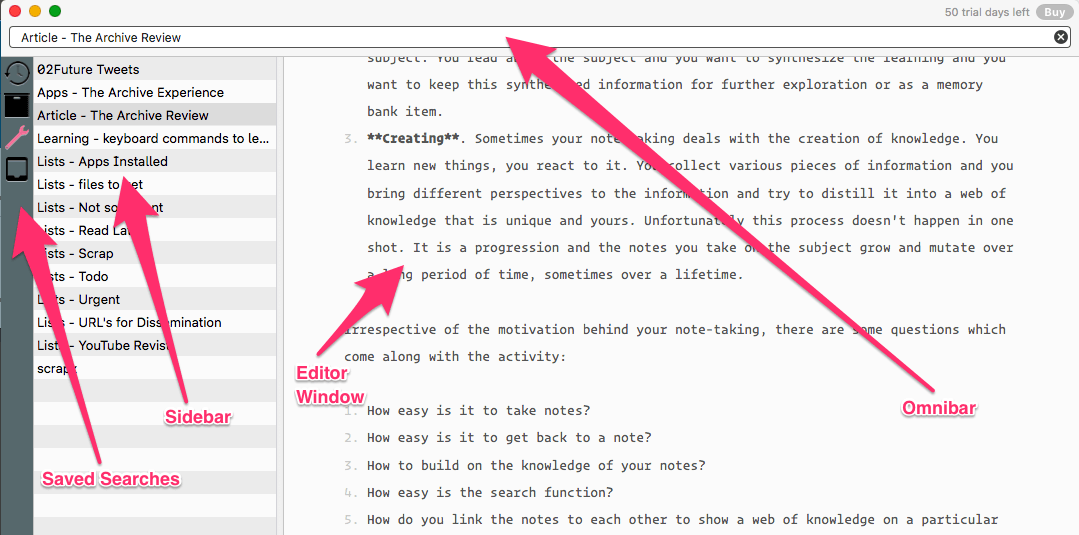 The Archive Window
The Archive Window
The Archive has four main components:
- The Omnibar. This is the place you type to search and create your new notes. It is a dual-use window to search your archive, and create new notes. Type something in the Omnibar and the application searches through your archive for the words you typed. A subset of your notes show up in the Sidebar, listing the notes that contain the words you typed. The Omnibar is also where you type the name of the new note you are creating. Just type the name of the new note and hit enter. You are now ready to add the contents of the note in the Editor window.
- The Editor. This is where you write your note. It is a Markdown compliant editor. Supports Gruber's Markdown.
- The Sidebar. This is the list of your notes. It is dynamic in the sense that it changes depending on what you have on the Omnibar. If the Omnibar is empty of content, this is the list of all the notes in the folder of the archive. If the Omnibar has some content, the Sidebar contains the files which contain the words in the Sidebar.
- Saved searches. In The Archive you have the ability to save frequently used searches and they show up on the side.
The Editor
This is where you are going to spend most of your time in this program. It is Markdown compliant. It supports Gruber's Markdown. Unfortunately, the technology has moved on from that basic implementation and now there are many different flavors of Markdown. I would have preferred support for CommonMark. Markdown support in these new incarnations like CommonMark, MultiMarkdown, and Github Flavored Markdown, has been extended to tables, table of contents and footnotes. The implementation of Markdown in The Archive does not support any of these enhancements to Markdown. This hampers the editing function in The Archive. The good news is that The Archive includes an option to edit the note in an external editor (⇧⌘E). So in a note which has the need for advanced Markdown support, I use the option to edit the note in my designated editor, Composer. I edit in Composer and use The Archive to manage the files. You have the ability to designate your favorite Markdown editor in the preferences as the external editor.
The Archive is a nice place to write in. The editor supports syntax highlighting for Markdown and does have some nice touches like typewriter scrolling built in. I would have liked extended support for writing Markdown. For instance, the program supports automatically completing the brackets used in Markdown but it could add support for some features that make writing Markdown links easier:
- Highlight a word and copy an URL from your clipboard to make that word a link.
- Highlight a word and press a keyboard command to put the word in brackets and let me add an URL surrounded by brackets.
The editor lets you do away with the sidebar when you are writing (⌃⌘S). That gives you a barebones editor window. It is useful if you want to limit distractions and write in The Archive.
Saved Searches
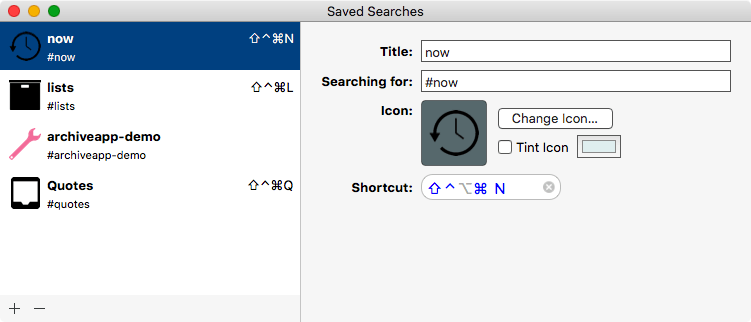 Saved Searches
Saved Searches
If you have a fair few notes (my archive of notes contains about 2800 notes), you are going to be periodically performing searches on the notes. The Archive gives you the ability to save searches you regularly perform. They show up in the leftmost panel. You can assign icons to help you identify them. There is a pop-up indicator panel if you hover your mouse cursor over the items. You can assign a keyboard command to a saved search. This is an example of the attention to detail which makes The Archive an absolute pleasure to use.
Saved searches makes it possible for me to build a repository of some of the repetitive searches that I find myself doing when I interact with my collection of notes. Saved searches are analogous to smart folders in the macOS world and are an useful addition to the act of interacting with my notes.
The Archive Improves on nvALT
I love nvALT. I have been using it for years. Brett Terpstra and David Halter, building on the core of Notational Velocity, have created a product which has grown to define note-taking on the macOS platform. The Archive improves on nvALT in several ways.
The Ability to Use Multiple Archives
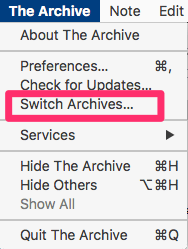 Switch Archives
Switch Archives
nvALT has always been constrained in that it supports one folder of notes. Changing the archive of notes to a different one required a fair amount of work. The Archive gives you the ability to have several archives of notes, and the process of switching between them is convenient and quick.
Choose Switch Archives… from the The Archive menu and you get to select the folder containing a different archive of notes. For those of you who want to keep separate archive of your notes, for instance, a folder for your personal notes and a folder for your work notes, this is a feature which is going to make you happy.
Provides a Theoretical Framework to the Process of Note-Taking
nvALT and its predecessor Notational Velocity were both a system for dealing with your notes. They were not build around a theoretical framework of any kind. They were focused on providing you a way of dealing with a bunch of files in a folder. They performed that task well, but The Archive extends the paradigm by providing the tools which weds your note-taking to the Zettelkästen method. Extending the product allows the user to see a process. To understand and use the notion of a progression of knowledge gathering, cultivating and creating. Your notes under The Archive is not a collection of individual notes. It is a collection of interconnected notes which has the potential for expansion and illumination by means of the linkages between them.
What was once a bunch of notes can under The Archive be conceived as a growing organism which builds on each other to create a web of knowledge. I am most excited by this aspect of The Archive. It has allowed me to delve into my notes and rearrange them to take advantage of explicit and implied linkages among them.
Ignore the Theory. Handle My Notes.
If you are not interested in Zettelkästen and just want to write notes and manage them in The Archive, it does that fine. You do not have to think about any underlying theory or framework to interact with your notes. Think about The Archive as the application which manages your notes and have at it. You can setup The Archive any way you want to, that makes it possible to keep using your old notes files and not worry about a new way to do things. The Archive handles text files with any plain text extension you throw at it.
Saved Searches Are Convenient
The idea that you can define a search criteria and save it for future use makes the task of handling a large number of notes easier. I can work on a smaller segment of my notes and be focused on the subject that I am working on. Makes it possible to intelligently segment my notes through the use of tags and saved searches aids the process of retrieval.
Stability and Peace of Mind
nvALT being freeware is dependent on the developers maintaining the project. There is no commercial reason for Brett or David to spend a second of their time on making sure that the product runs on the latest iteration of the macOS. They have been fantastic in making sure that the program runs and runs so well in High Sierra, but it is not a commercially motivated move. It is a labor of love. I am thankful to them for their continued support for nvALT.
However, I am always worried. I am eagerly waiting the advent of Bitwriter, the rumored commercial successor to nvALT. In the meantime, The Archive is a program which I have confidence in. This is version 1.0 from a developer who is interested in making the product a commercial success. Having participated in the beta program I am aware of the work that has gone in to the product to achieve the milestone release and am confident of a long and fruitful run in the marketplace. The developers of The Archive have a revenue stream to motivate them to keep working on this product and that gives me peace of mind. It is a product which does have the potential to become one of the dominant players in the field of note-taking on the macOS. This gives me peace of mind. I am putting my faith into a product which will be around for a while.
Software Agnosticism
The developers introduce a concept called Software Agnosticism to software development which is new to me. In simple words, this approach to software development has some discrete outcomes for the consumer which are easy to see:
- The goal of the product is to solve a problem. The problem in this case is note-taking and the goal of the product is to solve the problem through the implementation of the Zettelkästen method to the task of note-taking. The Archive is optimized to fit this problem.
- There is no lock-in. The end product of the file is plain text files. You can use any text editor you want to access and create these text files. Doesn't have to be The Archive. You are not dependent on The Archive for the continued access to your files. You can move on to another solution if that appears to be the best decision. This lets the user be in control of her destiny and not dependent on the vagaries of the software marketplace. If tomorrow something happens to The Archive or the developers do something to the product which makes it incompatible to my goals, I can take the collection of text files to any other program which fits my needs better without any friction. Very different from the Microsoft, Adobe and Apple way of doing software design.
- The developers themselves are keen adherents of the Zettelkästen method. They have "skin in the game." This is not only a commercial project for them. This is a way of life for them. This makes the act of adopting the product and the underlying concepts behind it, less risky for the consumer.
Setting up The Archive
The Archive has an adequate system of preferences which you can tweak to get the best experience customized for you.
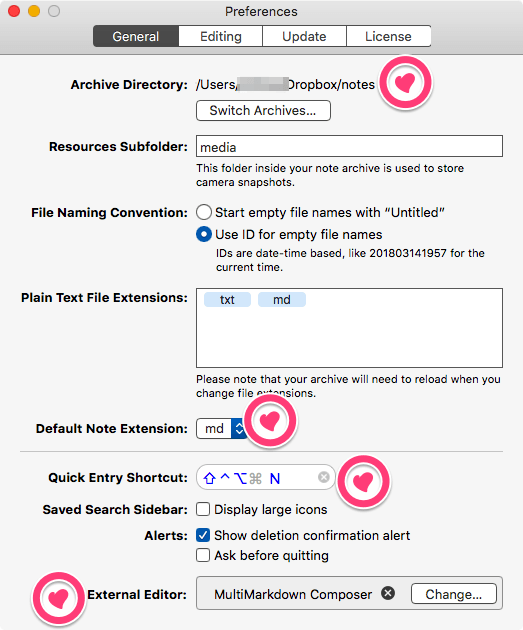 The Archive Preferences General
The Archive Preferences General
You can specify the location of your Archive folder. It can be a Dropbox hosted folder. That enables you to have the same collection of text files available across devices.
You can set a default note extension to use for your notes. Some people like using .txt, I am more comfortable with .md. Sublime Text 3 handles my .txt files. While Composer handles my .md or Markdown files.
The Archive lets you set a keyboard command for the global Quick Entry Shortcut. Also lets you assign an external editor of your choice , if you desire.
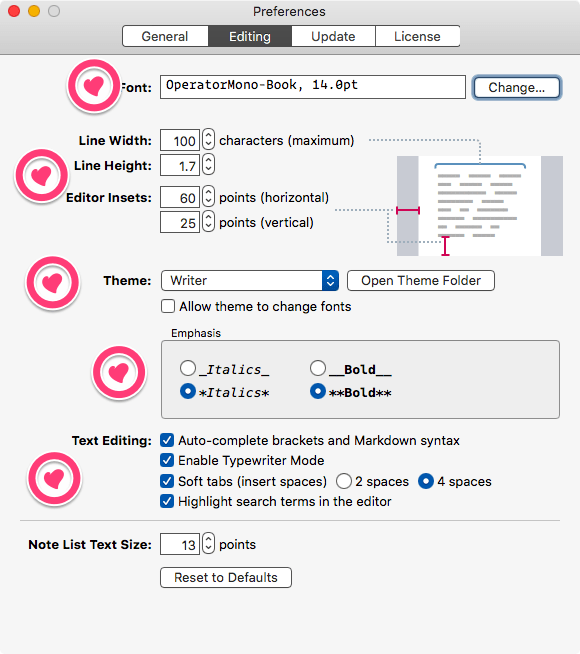 The Archive Preferences Editing
The Archive Preferences Editing
In the Editing panel of The Archive's Preferences you get to assign the font you want to write in. You get to control line width and the line height. You also get to control the amount of space around your text through the Editor Insets control.
Choose a theme. Define the markup for italics and bold. I like typewriter scrolling and am glad to have that available in The Archive.
Some Random features/thoughts
Note ID. I have always used descriptive file names for my notes. For instance, I might have a file called "Info - The Archive keyboard commands," which contains the keyboard commands which are available to me in The Archive. This system lets me have an alphabetically sorted list of notes on the sidebar. It is kind of an inefficient way of finding the file that I am interested in. When the archive of notes grew, I decided to include tags in the files. Tags help me collect similar files together and also lets me search my archive based on the tags. That is what I have been using till The Archive came along.
To create links between notes, you need to define how to target a note first. One response is to use file names. If you want clickable links the full path to the note could be used. However this is a fragile solution. It breaks when file names change or the location of the file changes. A better answer is to use an unique ID for each file. The Archive uses a timestamp ID. These timestamp IDs are by definition unique. For instance the timestamp ID 20180314211534 is based on the date 2018-03-14 and time 21:15:34. This is unique to this ID. If you name a file based on the timestamp ID, it will have an unique ID. Thus it will have the ability to be linked to by enclosing the ID in double brackets, which is how The Archive extends the ability of text files to link to other files. Try it, it is absolutely magic.
Changing List Type. You can create a list and change your mind about the kind of list you want. For instance, you have an ordered list. Highlight the list and select Format>Switch List Type or, press ⌘T. It changes to plain body text. Press ⌘T again, it changes into an unordered list. Neat and useful.
Tags. I love the implementation of tags in The Archive. The act of being clickable makes the tags useful and something that I have grown to rely on.
External Link URL Schemes. The Archive supports the following URL schemes:
- thearchive://search/TERM searches for TERM as if you typed it in
- thearchive://match/TERM works like the search but displays a good match directly; this is similar to [[Wiki-Links]].
- thearchive://matchOrCreate/TERM will create a note of the exact title TERM if that doesn’t exist; it’s similar to entering a search term into the Omnibar and hitting the return key.
Scripting and automation experts can add Alfred workflows and Keyboard Maestro macros to talk to The Archive directly.
The Roadmap. The developers of The Archive explicitly make available on the product web site the roadmap for the product. Here: The Archive Roadmap • Zettelkasten Method. This transparency is rare and appreciated.
An explicit published roadmap lets the user know what the future of the product holds in store. I wish more software development houses were this candid and open with their users.
Resources. The Zettelkästen forum is a great resource for all things Zettelkästen. I have been learning from the other users of the forum for the past few months and it is a great resource for anyone interested in trying to optimize their use of notes.
Areas for improvement:
Any version 1.0 product has room to grow, and these are my suggestions.
- Highlight a word and paste an URL to create a Markdown formatted link.
- Support CommonMark or MultiMarkdown.
- A keyboard command to input header levels.
- Bring explicit support for Markdown tables into the editor. Integrate your other product TableFlip into The Archive or let those two talk to each other.
Conclusion
The Archive blends the power and simplicity of nvALT with the elegance and efficacy of a digital Zettelkästen system to bring order and clarity to your note-taking system.
I have been using The Archive for the last few months. Being a part of the beta program (I am the anonymous one) has given me an appreciation for the progression of the product, the dedication of the developers and the humanity of the community surrounding the product. I am honored to be a part of this exceptionally bright and generous community.
The product is well designed and efficient. The developers are responsive and thoughtful.
If you are serious about your note-taking, you need to give The Archive a trial. I recommend the product heartily.
Acknowledgement
Some of the material, specially the section on Zettelkästen is copied from the help files that Christian, one of the developers of The Archive wrote during the beta period.
macosxguru at the gmail thingie
Note-taking Zettelkästen macOS